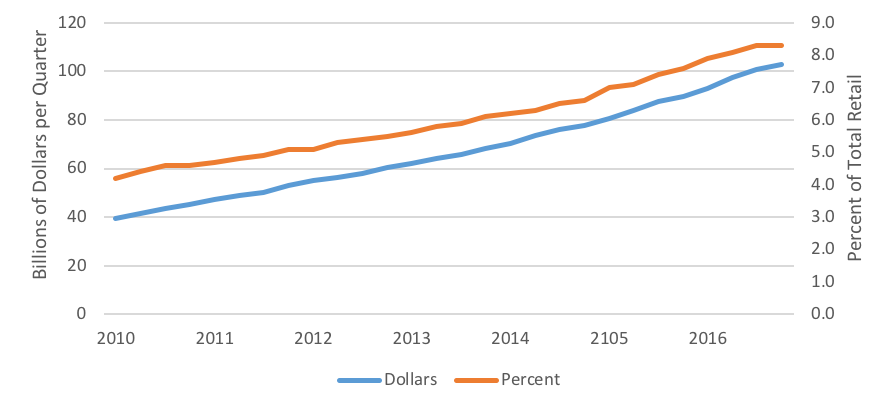Final 50 feet and Urban Deliveries Problem
The concept of Final 50-feet refers to the behavior of trucks when they are parked at or moving near the point of pick-up or delivery, especially in dense urban areas.
Local truck deliveries during daytime business hours both contribute to, and are affected by congestion on streets of a central business district. These local deliveries include activities such as parcel pickups and drop-offs at homes and businesses and product deliveries to stores. The traffic disruptions associated with these deliveries have negative impacts on productivity, quality of life and air quality. Increasing online commerce, shown in the figure, is one driver of urban freight traffic, as consumers’ shopping trips are being replaced by multiple deliveries throughout the week. Another driver of delivery traffic and congestion is the use of just-in-time inventories for stores and restaurants. For example, New York City’s 18,000 restaurants receive an average of three to four deliveries per day, creating an estimated 72,000 to 96,000 daily truck trips in the city, just for restaurant supply (Regional Plan Association, 2016).
Local deliveries contribute to congestion in two ways: 1) loading and unloading trucks occupy parking spots or block traffic lanes, and 2) drivers spend time circling city blocks in search of proper parking. These parking and driving behaviors are a result of and contributor to urban congestion and an estimated 947,000 hours of vehicle delay per day are attributed to delivery truck parking (Oak Ridge National Laboratory, 2004). The consequence of this congestion may lead to lost productivity, increased air pollution, and decreased the quality of life in urban areas. However, previous research on the use of delivery trucks for e-commerce in lieu of personal vehicles for shopping has consistently shown that use of delivery trucks create less Vehicle Miles Traveled and less carbon dioxide emissions than the use of personal vehicles (Goodchild & Toy, 2016).
E-Commerce Growth Trends

Traditional management practices for loading zones are oriented towards restricting access and have been unable to deal with increasing delivery traffic.”
These restrictive practices include designating specific areas as loading zones or designating specific hours of the day as delivery times. Restrictive approaches are insufficient to meet current loading zone needs because available spots are still lower than peak demand, and violation of loading zone restrictions (such as cars parked in zones) is not well-enough enforced, resulting in further reduced capacity.